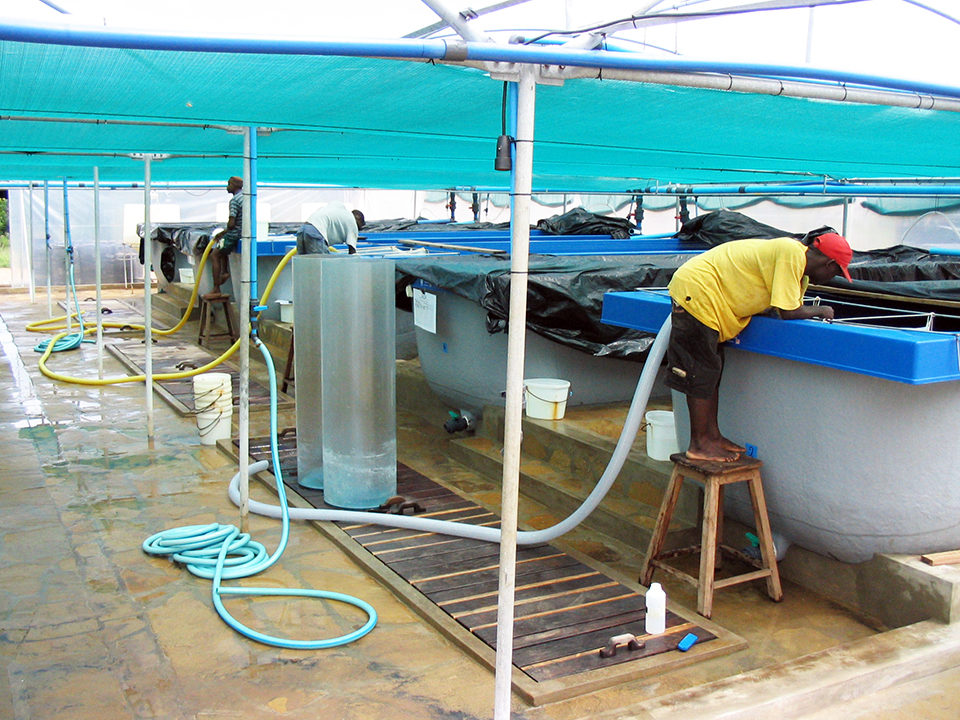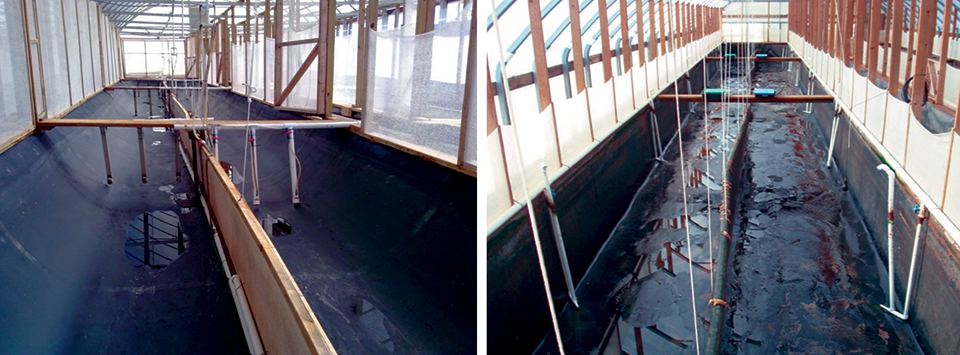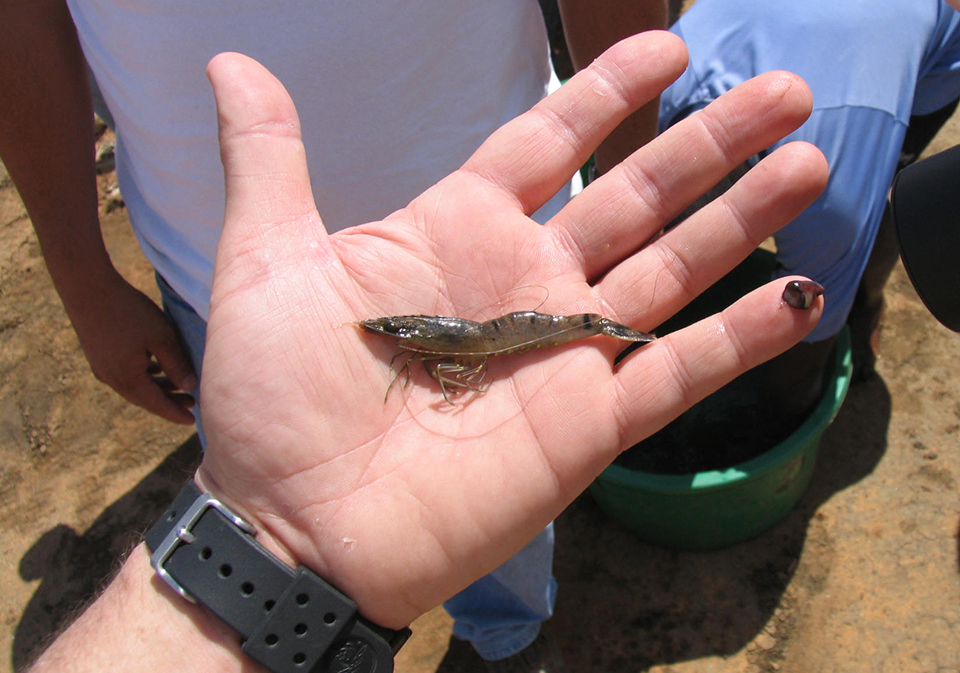Criteria, steps

The primary aim of commercial shrimp farming is not to rear healthy shrimp but to make money. Therefore, the main goal of biosecurity – activities that aim to prevent, control and eradicate risks to shrimp life and health – is to reduce the economic impact of diseases. Biosecurity should be regarded as a tool toward the sustainability of a company and increased profitability.
There are no standard biosecurity plans that can be applied to all operations. Each facility needs to develop its own plan. This requires full understanding of the design and operations of the facility, and knowledge of the animals’ health status and the transmission modes of pathogens in order to identify the risks and develop meaningful biosecurity measures.
Criteria
When evaluating and defining biosecurity measures, three rules must be kept in mind. Measures should be:
Justifiable. They should be scientifically sound. Company policies or personnel sanitation measures should not be included under the biosecurity umbrella, but should stand on their own.
Practical. They should not impede routine farming practices. Staff commitment and engagement are necessary for plan implementation, and their participation in optimizing the mitigation measures is desirable.
Economically viable. A balance should be found between the costs and benefits of the biosecurity measures.
Design steps
To design a biosecurity plan, a series of steps must be followed. These include acquiring knowledge of the stock’s current health status, the design and implementation of surveillance programs and selection of those pathogens targeted for control. Risk points must be identified and control measures defined. Diagnostic capacity must be developed, as well. Definition of a contingency strategy and planning for staff awareness building are also required.
Health status
The starting point is accurately determining the health and infectious status of the facility stocks. Some of the pathogens present may be known, but a full evaluation is needed. For that purpose, properly designed surveillance that minimizes the number of samples required while maximizing the information generated must be implemented.
Listed pathogens must be identified as the ones to keep under control or eradicate. Depending on the initial health status of the stock and the surrounding environment, the listed pathogens may refer exclusively to those associated with severe mortality and major economic impacts or that may affect growth and performance. This list should include only primary pathogens and avoid the inclusion of secondary ones such as Vibrio species.
Transmission of pathogens
Understanding the transmission of the listed pathogens is crucial to implement effective biosecurity measures. Two general pathways are important for shrimp pathogens: horizontal and vertical transmission. Horizontal transmission is from one shrimp to a neighboring shrimp or other susceptible host, whether it is directly via cannibalism or ingestion of contaminated food, via water (cohabitation) or via ingestion of contaminated feces.
Vertical transmission, on the other hand, is the transmission of infection from broodstock to their offspring. This can happen when pathogens are present inside the egg, so cleaning or disinfection of eggs or larvae does not prevent transmission. Vertical transmission also happens through contamination of the egg surface due to infection of the ovary stroma or sperm (per ovum).
Every systemic pathogen – white spot syndrome virus, yellow head virus, Taura syndrome virus, etc. – is suspected of per ovum transmission. For these, cleaning and disinfection of eggs is an option to break the transmission pathway.
However, not much success has been achieved by this means. In most cases, exclusion of per ovum pathogens requires the rejection of infected broodstock. Ingestion of infected feces during early larval stages is also a common route of transmission for enteric pathogens such as tetrahedral baculovirosis, spherical baculovirosis, and necrotizing hepatopancreatitis virus.
In terms of health management, shrimp viruses should be considered to cause persistent infections. Once animals are infected, they remain infected for life. The situation is similar with the intracellular bacteria NPH and Streptococcus. Streptococcus is responsible for extracellular infections, but it also has a component of intracellular infection in haemocytes. In these cases, antibiotic treatment is only partially successful, as the intracellular space is difficult to reach.
Risk identification
Risk identification and prioritization are the bases for the development of mitigation measures. These can be divided into major groups. Measures targeting the control of pathogen introduction to facilities are dealt with by external biosecurity. The other group is comprised of those measures targeting the spread of the pathogen within the facility, dealt with by internal biosecurity.
The first step in defining external biosecurity is to identify all the possible sources of pathogen introduction. The main sources could be shrimp for stocking, new broodstock, wild crustaceans in incoming water or that crawl through the banks, fresh feed, incoming water, birds or insects, vehicles and equipment, people, and effluents and solid waste from processing plants. Once these are identified, the appropriate procedures to control or reduce risk have to be determined and implemented.
For internal biosecurity, the first step is again the identification of all possible means of pathogen dissemination and the definition of appropriate procedures to control or reduce risk. When considering the risk of spreading a pathogen, there are two main parameters. One is the possibility of an item – equipment, clothing, shoe, etc. – carrying infectious viral particles, and the other is the possibility for those viral particles to reach a susceptible host.
Any circumstance in which shrimp come in contact with people, vehicles, equipment and surfaces represents a certain degree of risk. This also applies to contact with water and pond soil/mud, but at a lower level of risk.
Once the different risk activities have been identified, risk mitigation measures need to be defined. Most measures will require cleaning and disinfection procedures. Such measures should be incorporated into standard operating procedures for routine application.
Special emphasis should be placed on harvest operations. These represent a particularly high risk, as they require that a large volume of shrimp and water come into contact with people, vehicles, equipment and surfaces. Cleaning with strong detergent and soaking of all equipment and vehicles surfaces is required at the site of harvest.
Internal biosecurity
Some tools used in animal production can facilitate internal biosecurity at aquaculture facilities.
Fallowing
An ancient practice in agriculture, fallowing refers to land that is plowed and tilled but left unseeded during a growing season. Gaps in aquaculture production at a location are of great value in health management, as dry-out periods can break reinfection cycles. This should be performed regularly, ideally after every crop.
All-in-all-out
All-in-all-out strategies are regularly used in terrestrial animal production. In these systems, animals are kept together in groups by age and size. Animals of different ages do not mix within a section of the facility. These groups are moved together into the different phases of production. When a group moves forward, the section is completely emptied, cleaned and disinfected. This strategy reduces disease transmission by minimizing the risk of infection from older animals to younger animals. All animals within each group have a similar sanitary record and level of immune system development.
Compartmentalization
Compartmentalization is the process of defining areas that can be kept at a different sanitary status than the surrounding areas. The objective is to reduce the risk of pathogen spread by increasing the chances of control in maintaining areas free of a particular pathogen. Compartments should be as small as functionally possible, and each can have different degrees of biosecurity, such as maturation facilities versus growout ponds. In the presence of an infected compartment, buffer compartments should be created around it where the pathogen can be monitored to gain a clearer understanding of the spread of the disease.
Uniforms
Personnel movement from compartment to compartment implies risk, as clothes, shoes and bodies can act as viral carriers. To keep the highest staff movement control levels, as well as provide a higher degree of freedom for the staff, a color-based uniform system, including shoes, can be implemented. While the risk represented by contaminated clothes and shoes might not the highest, the main role of the uniforms in biosecurity might be considered that of mind setter.
Restricting vehicle movement
It seems unlikely for viable viral particles on vehicles to be able to reach a susceptible host. However, the possibility exists, and vehicle movement should be restricted to specific areas of concern. Often, due to economic reasons, not all mitigation measures can be implemented simultaneously. In those cases, priority should be given to those that tackle the highest biosecurity risks rather than those that are easier or less costly to implement.
(Editor’s Note: This article was originally published in the July/August 2010 print edition of the Global Aquaculture Advocate.)
Now that you've reached the end of the article ...
… please consider supporting GSA’s mission to advance responsible seafood practices through education, advocacy and third-party assurances. The Advocate aims to document the evolution of responsible seafood practices and share the expansive knowledge of our vast network of contributors.
By becoming a Global Seafood Alliance member, you’re ensuring that all of the pre-competitive work we do through member benefits, resources and events can continue. Individual membership costs just $50 a year.
Not a GSA member? Join us.
Author
-
Victoria Alday-Sanz, Ph.D.
Gran Via 658, 4-1
08010 Barcelona, Spain[109,111,99,46,111,111,104,97,121,64,121,97,100,108,97,95,97,105,114,111,116,99,105,118]
Tagged With
Related Posts

Health & Welfare
A comprehensive look at the Proficiency Test for farmed shrimp
The University of Arizona Aquaculture Pathology Laboratory has carried out the Proficiency Test (PT) since 2005, with 300-plus diagnostic laboratories participating while improving their capabilities in the diagnosis of several shrimp pathogens.

Responsibility
A look at various intensive shrimp farming systems in Asia
The impact of diseases led some Asian shrimp farming countries to develop biofloc and recirculation aquaculture system (RAS) production technologies. Treating incoming water for culture operations and wastewater treatment are biosecurity measures for disease prevention and control.

Responsibility
Advances in super-intensive, zero-exchange shrimp raceways
Research at the Texas AgriLife Research Mariculture Laboratory is investigating ways to improve the economic viability of super-intensive raceways for shrimp production.

Health & Welfare
Designing a biosecurity plan for shrimp aquaculture, part 2
The objective of a contingency plan is to quickly recover production through rapid initial response and effective implementation of biosecurity measures. Such plans depend on whether the detected pathogen or disease is exotic or endemic, its potential economic impacts and whether it is to be eradicated.



